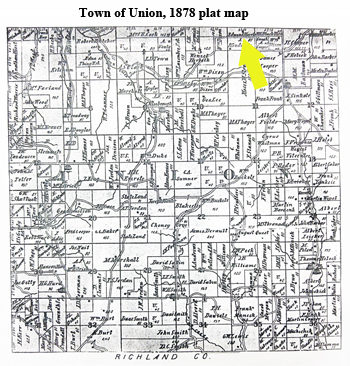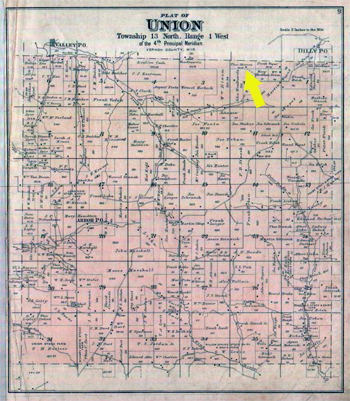Local History Topics
Cheyenne Valley
Museum Notes
by Kristen Parrott, curator
for the week of February 8, 2017
Paging through the 1884 Vernon County history book recently, I ran across a brief biography for Ed Harris, an early settler in the Town of Union. What caught my attention was that he was described as a former slave, from Tennessee. Many of the African Americans who settled in the Cheyenne Valley area, in the northeast corner of our county, were free Blacks who came here before the Civil War. But some were former slaves who arrived after the war, including Harris.
Trying to find definitive information about him has been complicated. Even his first name is a mystery. The 1884 book calls him Edward, the 1878 plat map calls him Edmund, and the 1870 and 1880 censuses refer to him as Edmond. For simplicity’s sake, I think of him as Ed.

Town of Union, 1878 plat map showing Ed Harris' land.
When and where he was born are also open questions. On the 1870 census he is listed as age 61, but 10 years later on the 1880 census he is listed as 62. Perhaps this was a census-taker’s mistake, or maybe Ed himself was uncertain of his birthdate. In addition, his birthplace is given first as North Carolina (1870 census), and then as West Tennessee (1880 census).
What do we know for sure? Various sources agree that Ed Harris was a farmer who owned land in section two of the Town of Union, on the northern edge of Union where it borders Forest. He was alive in 1880 but dead by 1884, and is probably buried in the Forest-Burr Cemetery.
We also know that Ed did not always live alone in Vernon County. Census records tell us that in 1870 he was on his own, but in 1875 he was living with a woman (no name or other details are recorded). This woman is probably the second wife that a few sources refer to, his first wife having died or been taken from him during slavery.
The big change comes on the 1880 census, when Ed Harris is listed as a widower living with a 21-year-old daughter named Mary, and a 23-year-old step-son named Thomas Shivers. Here the Harris family story intersects with the Shivers family story. Much has been written about the Shiverses because Thomas’ son Alga built many of the round barns that this region is famous for.

Town of Union, 1898 plat map showing Ed Harris' land now belongs to Thomas Shivers.
The relationship between Ed and Mary and Thomas is a little confusing. Some say that Thomas was the son, possibly adopted, of Ed’s second wife before she married him. Others say that Thomas was Ed’s nephew. As for Mary, she is generally believed to be Thomas’ sister and therefore a Shivers, but the 1880 census gives her name as Mary Harris. Working with census records can be frustrating, with lots of information that may or may not be accurate.
The little we do know about Ed Harris leaves us with so many questions. How did he come to Vernon County? Who did he know here before he arrived – that is, who contacted him to say that this would be a good place to live? What was it like to start a new life, alone, in a strange place, in your 40s or 50s, after having been a slave? How did his family members make their way to him and his new home? New sources of information occasionally come to light, and we may have more answers someday.

 MENU
MENU